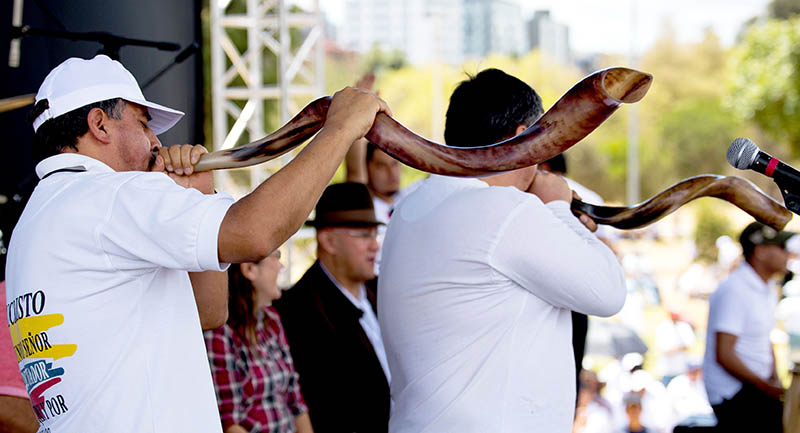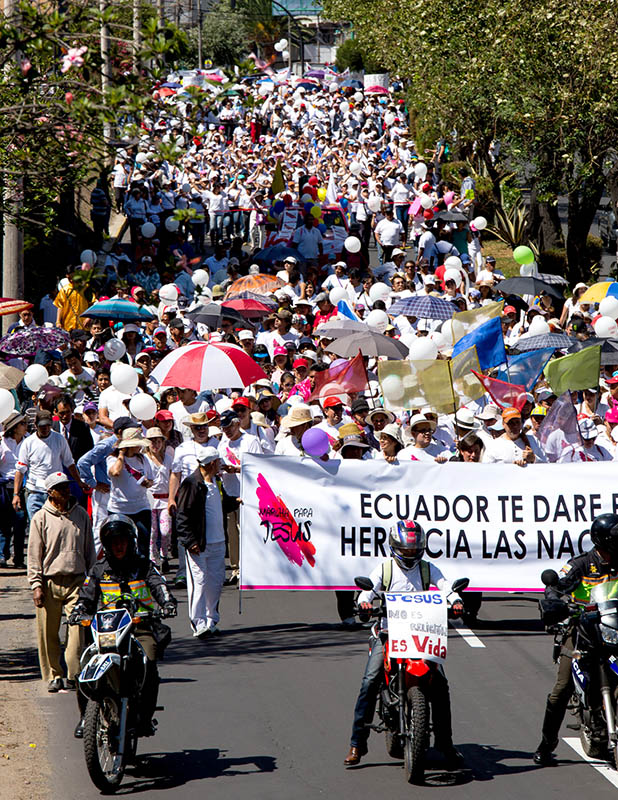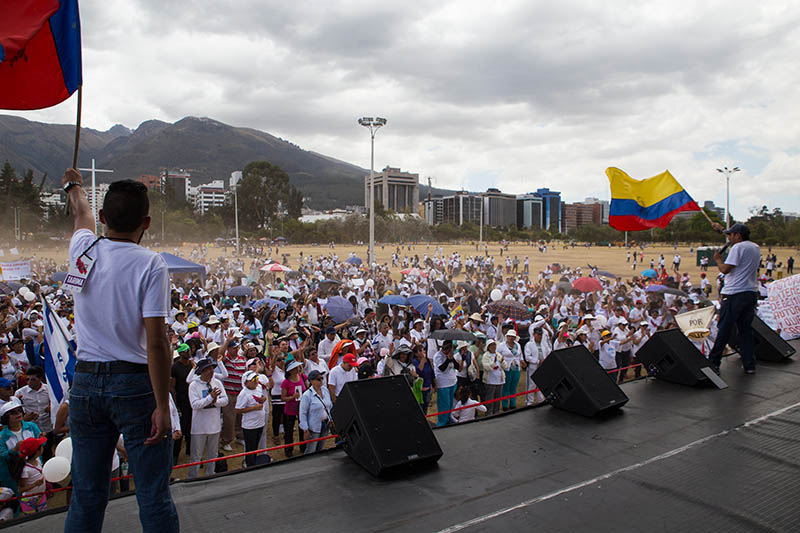MENU
(Oct. 5, 2015 - by Ralph Kurtenbach) Pastor Alejandro Vizuete stands at the edge of Parque El Ejido, a popular park, as crowds mull about and begin forming a column to begin a march through Ecuador’s capital city of Quito.
 Casually he lifts to his lips a shofar, a musical instrument made from the horn of an animal, typically a ram. The shofar isn’t Ecuadorian; it comes from ancient Israel. Vizuete blows a long blast followed by pitch-varied, staccato notes. A clarion call, it would have alerted an entire encampment in a different era.
Casually he lifts to his lips a shofar, a musical instrument made from the horn of an animal, typically a ram. The shofar isn’t Ecuadorian; it comes from ancient Israel. Vizuete blows a long blast followed by pitch-varied, staccato notes. A clarion call, it would have alerted an entire encampment in a different era.
In Quito on Saturday, Sept. 26, however, competition comes from many sources—blaring bus horns, vendors hawking hats and T-shirts, and others chanting as they wait for the Marcha para Jesús (March for Jesus) to begin.
“The shofar was used in Israel to call together a congregation or to sound the alarm of battle,” Vizuete explained. “It was used to make an announcement.” Asked if battle is a contemporary threat, he acknowledged that “there is a spiritual conflict. In the Bible it is said to be the classic conflict between the kingdoms of good and evil.”
The march began as thousands of Ecuadorians clad in white set off from El Ejido, representing numerous evangelical churches in the city. They sang, danced, chanted and prayed as they made their way northward to another park, La Carolina.
“The white was … a symbol of peace, holiness, consecration,” noted Vizuete. “People were asked to come dressed in white.”
 “We have not had an event like this for several years,” added Leonardo Gutiérrez who attends Iglesia Alianza Norte (Northside Alliance Church). “I believe it’s needed for people to find peace by getting closer to Jesus.”
“We have not had an event like this for several years,” added Leonardo Gutiérrez who attends Iglesia Alianza Norte (Northside Alliance Church). “I believe it’s needed for people to find peace by getting closer to Jesus.”
Gutiérrez continued that “it’s important for society to realize that His followers are concerned about changes taking place in society.” He did not elaborate. The march was decidedly apolitical in a country recently jolted by protests against public policy.
Vizuete ministers in La Marín, a densely populated area near the center of Quito. When pressed, he disclosed the denominational specifics—a Foursquare church—but quickly added that the march underscored unity, not differences.
“Here we’re not emphasizing that,” he said. “Instead, this march is to exalt Jesus alone … putting His name at the highest. That’s our goal—that the name of Jesus may be lifted up.”
March for Jesus has its roots in interdenominational collaboration, emerging from friendships among people involved in church and parachurch work in England. Begun in London in 1987, the march grew rapidly, spreading across Europe and North America. By 1994 an estimated 10 million Christians staged the first Global March for Jesus in over 170 countries.
Pre-event promotion of Quito’s Marcha para Jesús aired on Radio Station HCJB with public service announcements as well as nightly interviews hosted by Pastor Dairo Rubio (one of the organizers) beginning a few weeks ahead of the march.
 Participants also included Gloria Morales and José Daza and others from the Centro Cristiano International Josué (Joshua Christian Center International) in the El Camal sector of south Quito.
Participants also included Gloria Morales and José Daza and others from the Centro Cristiano International Josué (Joshua Christian Center International) in the El Camal sector of south Quito.
“We’re all here on our fourth march of this kind,” said Daza. “We’re crying for the nation of Ecuador [here] and throughout Ecuador.” Other such marches have been held in Ecuadorian cities such as Riobamba (on Aug. 8), Loja, Quevedo and Portoviejo.
Asked if she planned to march all the way to the finish, Morales replied that she would “with God’s help.” The distance was some 2½ miles and required stopping for cross traffic at first, according to Reach Beyond missionary Jody Arnold who participated with her husband, Scott. Farther ahead, side streets were blocked, giving the marchers the right-of-way.
The Arnolds had learned about the march from their church in north Quito whose pastor, Edgar Silva, played saxophone with other musicians at an outdoor service at La Carolina when the marchers arrived.
Jody Arnold said that at street level on Saturday “as far ahead as I looked I could not see the beginning of the march, and when I looked behind us I could not see the end of it either.”
Photo credit: Bryan Rubio
Source: Reach Beyond
 Casually he lifts to his lips a shofar, a musical instrument made from the horn of an animal, typically a ram. The shofar isn’t Ecuadorian; it comes from ancient Israel. Vizuete blows a long blast followed by pitch-varied, staccato notes. A clarion call, it would have alerted an entire encampment in a different era.
Casually he lifts to his lips a shofar, a musical instrument made from the horn of an animal, typically a ram. The shofar isn’t Ecuadorian; it comes from ancient Israel. Vizuete blows a long blast followed by pitch-varied, staccato notes. A clarion call, it would have alerted an entire encampment in a different era.In Quito on Saturday, Sept. 26, however, competition comes from many sources—blaring bus horns, vendors hawking hats and T-shirts, and others chanting as they wait for the Marcha para Jesús (March for Jesus) to begin.
“The shofar was used in Israel to call together a congregation or to sound the alarm of battle,” Vizuete explained. “It was used to make an announcement.” Asked if battle is a contemporary threat, he acknowledged that “there is a spiritual conflict. In the Bible it is said to be the classic conflict between the kingdoms of good and evil.”
The march began as thousands of Ecuadorians clad in white set off from El Ejido, representing numerous evangelical churches in the city. They sang, danced, chanted and prayed as they made their way northward to another park, La Carolina.
“The white was … a symbol of peace, holiness, consecration,” noted Vizuete. “People were asked to come dressed in white.”
 “We have not had an event like this for several years,” added Leonardo Gutiérrez who attends Iglesia Alianza Norte (Northside Alliance Church). “I believe it’s needed for people to find peace by getting closer to Jesus.”
“We have not had an event like this for several years,” added Leonardo Gutiérrez who attends Iglesia Alianza Norte (Northside Alliance Church). “I believe it’s needed for people to find peace by getting closer to Jesus.”Gutiérrez continued that “it’s important for society to realize that His followers are concerned about changes taking place in society.” He did not elaborate. The march was decidedly apolitical in a country recently jolted by protests against public policy.
Vizuete ministers in La Marín, a densely populated area near the center of Quito. When pressed, he disclosed the denominational specifics—a Foursquare church—but quickly added that the march underscored unity, not differences.
“Here we’re not emphasizing that,” he said. “Instead, this march is to exalt Jesus alone … putting His name at the highest. That’s our goal—that the name of Jesus may be lifted up.”
March for Jesus has its roots in interdenominational collaboration, emerging from friendships among people involved in church and parachurch work in England. Begun in London in 1987, the march grew rapidly, spreading across Europe and North America. By 1994 an estimated 10 million Christians staged the first Global March for Jesus in over 170 countries.
Pre-event promotion of Quito’s Marcha para Jesús aired on Radio Station HCJB with public service announcements as well as nightly interviews hosted by Pastor Dairo Rubio (one of the organizers) beginning a few weeks ahead of the march.
 Participants also included Gloria Morales and José Daza and others from the Centro Cristiano International Josué (Joshua Christian Center International) in the El Camal sector of south Quito.
Participants also included Gloria Morales and José Daza and others from the Centro Cristiano International Josué (Joshua Christian Center International) in the El Camal sector of south Quito.“We’re all here on our fourth march of this kind,” said Daza. “We’re crying for the nation of Ecuador [here] and throughout Ecuador.” Other such marches have been held in Ecuadorian cities such as Riobamba (on Aug. 8), Loja, Quevedo and Portoviejo.
Asked if she planned to march all the way to the finish, Morales replied that she would “with God’s help.” The distance was some 2½ miles and required stopping for cross traffic at first, according to Reach Beyond missionary Jody Arnold who participated with her husband, Scott. Farther ahead, side streets were blocked, giving the marchers the right-of-way.
The Arnolds had learned about the march from their church in north Quito whose pastor, Edgar Silva, played saxophone with other musicians at an outdoor service at La Carolina when the marchers arrived.
Jody Arnold said that at street level on Saturday “as far ahead as I looked I could not see the beginning of the march, and when I looked behind us I could not see the end of it either.”
Photo credit: Bryan Rubio
Source: Reach Beyond
